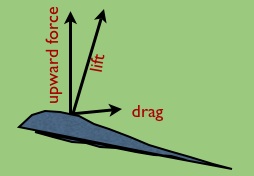|
|
|
Drag :
There are
actually a number of drags that come into play during flight. However,
when we refer to ‘drag’, we generally mean a sum of all the drag
forces.
The coefficient of drag is
defined as

with A being the
area of the wing surface, D is the drag, and r being the fluid density.
The different drag forces are :
Viscous Drag :
The boundary layer on the surface of the wing has zero velocity, while
there is freely flowing fluid at the other end (the top) of this layer.
This results in a shear, and the drag results from the fluid’s
resistance to this shear.
Pressure Drag or Inertial Drag :
As an object moves through a fluid, it generates a turbulent wake
behind it. The pressure in this wake is lower than that in the front,
thus resulting in a backward pull.
With l taken as the
width of the wing, and m being the dynamic viscosity, such
that, n=m/r is the kinematic viscosity, the Reynold's number
defined as

For
Re < 1 viscous drag is important
Re > 1 pressure
drag
is important
The
lift increases with the angle of
attack (the angle (a) between the chord and the direction of flight)
till
the stall angle is reached. Beyond the stall angle, the wake behind the
wing becomes turbulent, causing an increase in drag - and this is
called stall.
So,
the angle of attack cannot be increased indefinitely to enhance lift!
The stall angle is typically 20° for birds, 30°
for grass hoppers and 50° for fruitflies.
Induced
Drag : This drag is the ‘price’ for the lift. The lift is
perpendicular to the direction of motion of the wing. Hence, when the
wing is not horizontal (that is, there is a non-zero angle of attack),
the horizontal component of the lift acts as a drag, while the upward
component works against the gravitational pull.

Induced drag
However,
in practical situations, the induced drag is much smaller than the
vertical component of the lift.
The aspect ratio
may be defined as L = s/c
where s is the wing span (distance between wing tips) and c is
the average chord length.
Higher
the aspect ratio, lesser the tip vortices. Thus, long, slender wings
will have lesser induced drag. But, this, too, has a limitation. Flying
amidst tall trees, with very long wings, is also not the most
acceptable idea!
Web Project by Debasmita Samaddar
PHYS 645, University of Alaska
Fairbanks
Fall - 2007
source for template
-> Free web templates
|
|



